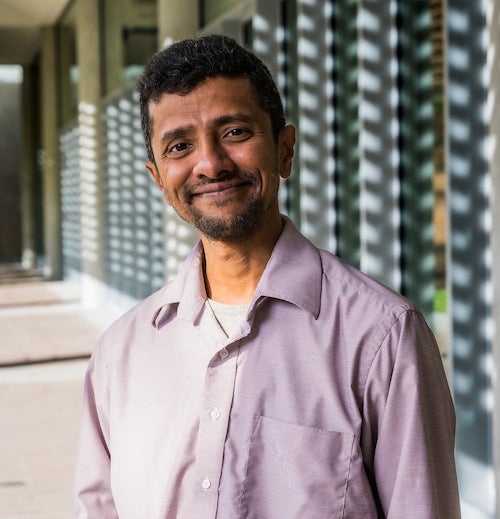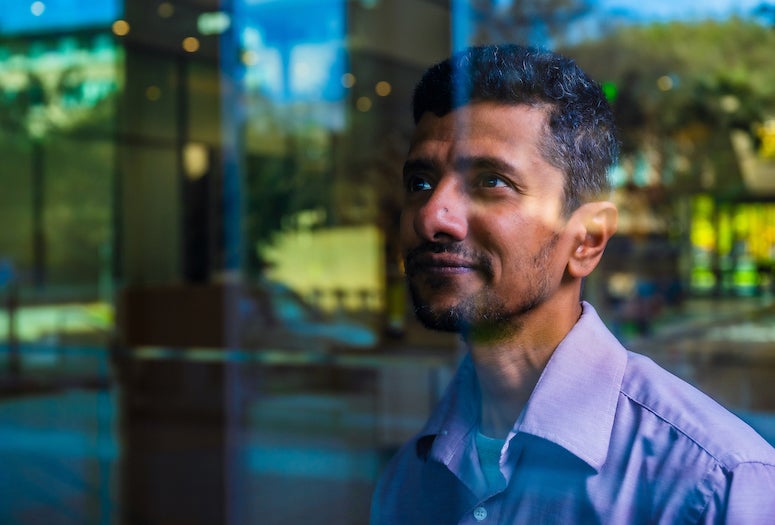Rice University’s Ashok Veeraraghavan has been awarded the Edith and Peter O’Donnell Award in Engineering from the Texas Academy of Medicine, Engineering, Science and Technology (TAMEST), one of the state’s highest academic honors.

The O’Donnell Awards are given annually to star researchers in the state who are engaged in pathbreaking work in medicine, engineering, biological sciences, physical sciences and technology innovation. This year’s engineering award goes to Veeraraghavan, professor of electrical and computer engineering at Rice, who was recognized for his group’s “revolutionary imaging technology that seeks to make the invisible visible,” according to a statement from TAMEST.
Veeraraghavan’s computational imaging lab researches imaging processes holistically, from optics and sensor design to machine learning processing algorithms, to tackle imaging challenges that are otherwise beyond the reach of current technologies.
“Most imaging systems today are designed in a way that does not take all these three things into account together ⎯ they are designed separately,” Veeraraghavan said. “Co-design opens up new degrees of freedom and allows us to achieve some imaging functionalities or performance capabilities that are otherwise not possible.”
Veeraraghavan’s research seeks to provide solutions for imaging scenarios where the visualization target is inaccessible to current imaging technologies due to the scattering of light in participating media.
“There are many examples of this,” Veeraraghavan said. “One familiar example is when you’re driving a car and it’s foggy, so you can’t see too far out. In this case, fog acts as the scattering medium. If you’re doing satellite imaging, clouds can act as the scattering medium. And if you’re doing biological imaging, it’s skin that acts as the obscurant that makes it so you can’t see blood cells or the structure of the vascular system, for example.
“In all of these contexts, the main challenge is that light interacts with participating media and scatters, which means you lose information about the image you are trying to capture. I think imaging through scattering media is really one of the most challenging problems that’s left in imaging. So that is what the core focus of my lab is, and we’ve made significant advances toward solving that problem.”
Luay Nakhleh, the William and Stephanie Sick Dean of Engineering and professor of computer science and biosciences at Rice, congratulated Veeraraghavan for his achievement.
“Ashok’s work is characterized by innovation and creativity, and so he richly deserves this special recognition,” Nakhleh said. “In fact, this is extra special for our school since it is the second year in a row that one of our faculty receives the O’Donnell Award, with Jamie Padgett being last year’s recipient.”
Ramamoorthy Ramesh, Rice’s executive vice president for research and a professor of materials science and nanoengineering and of physics and astronomy, praised Veeraraghavan and underscored the impact of his research.
“I’m so pleased to see Ashok recognized with the Edith and Peter O’Donnell Award, joining an accomplished group of prior Rice University recipients,” Ramesh said. “Ashok has used math and technology to solve some of the most difficult problems in imaging. His work has broad applications for the advancement of human health, microscopy, national security, autonomous vehicles, photography and so much more.”
Winners of the 2024 Edith and Peter O’Donnell Award will be formally recognized during a ceremony in Austin in February. They will also give presentations about their work at the TAMEST 2024 Annual Conference .
Co-founded in 2004 by Rice Nobel laureate Richard Smalley, TAMEST is a 330-member organization composed of Texas-based Nobel laureates and members of the National Academy of Sciences, the National Academy of Medicine, the National Academy of Engineering and the Royal Society.
- Video is available at:
-
https://youtu.be/7TLWtW-rOdU
Credit: TAMEST - Image downloads:
-
https://news-network.rice.edu/news/files/2024/01/231207_1_Fitlow_024.jpg
CAPTION: Ashok Veeraraghavan is a professor of electrical and computer engineering at Rice University.
(Photo by Jeff Fitlow/Rice University)
https://news-network.rice.edu/news/files/2024/01/231207_1_Fitlow_012_crop.jpg
CAPTION: Ashok Veeraraghavan is the recipient of the 2024 Edith and Peter O’Donnell Award in Engineering from the Texas Academy of Medicine, Engineering, Science and Technology (TAMEST). (Photo by Jeff Fitlow/Rice University)
- Related stories:
-
NeuWS camera answers ‘holy grail problem’ in optical imaging:
https://news.rice.edu/news/2023/neuws-camera-answers-holy-grail-problem-optical-imaging
Rice’s Jamie Padgett wins Texas academy’s O’Donnell Award:
https://news.rice.edu/news/2023/rices-jamie-padgett-wins-texas-academys-odonnell-award
Ashok Veeraraghavan named IEEE Fellow:
https://kenkennedy.rice.edu/news/current-news/ashok-veeraraghavan-named-ieee-fellow - Links:
-
Ashok Veeraraghavan website: https://computationalimaging.rice.edu/
Department of Electrical and Computer Engineering: https://www.ece.rice.edu/Department of Computer Science: https://csweb.rice.edu/
George R. Brown School of Engineering: https://engineering.rice.edu
- About Rice:
-
Located on a 300-acre forested campus in Houston, Rice University is consistently ranked among the nation’s top 20 universities by U.S. News & World Report. Rice has highly respected schools of architecture, business, continuing studies, engineering, humanities, music, natural sciences and social sciences and is home to the Baker Institute for Public Policy. With 4,574 undergraduates and 3,982 graduate students, Rice’s undergraduate student-to-faculty ratio is just under 6-to-1. Its residential college system builds close-knit communities and lifelong friendships, just one reason why Rice is ranked No. 1 for lots of race/class interaction, No. 2 for best-run colleges and No. 12 for quality of life by the Princeton Review. Rice is also rated as a best value among private universities by Kiplinger’s Personal Finance.

